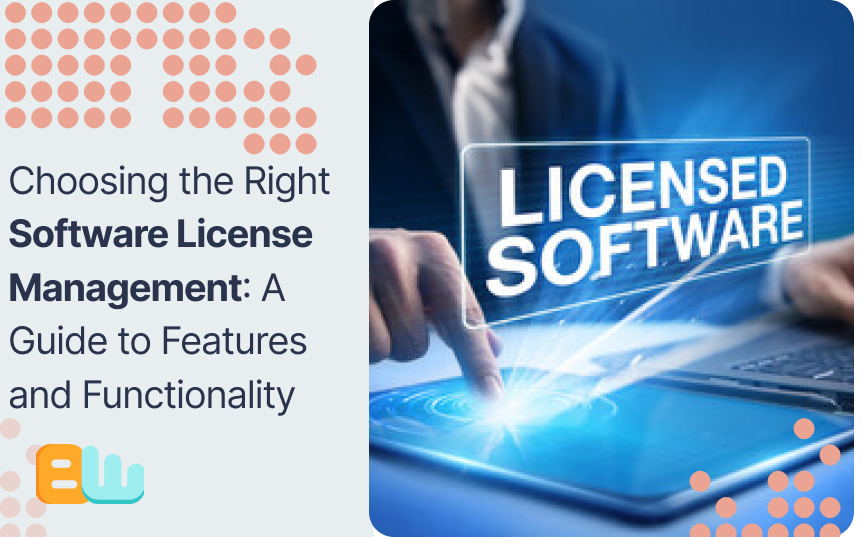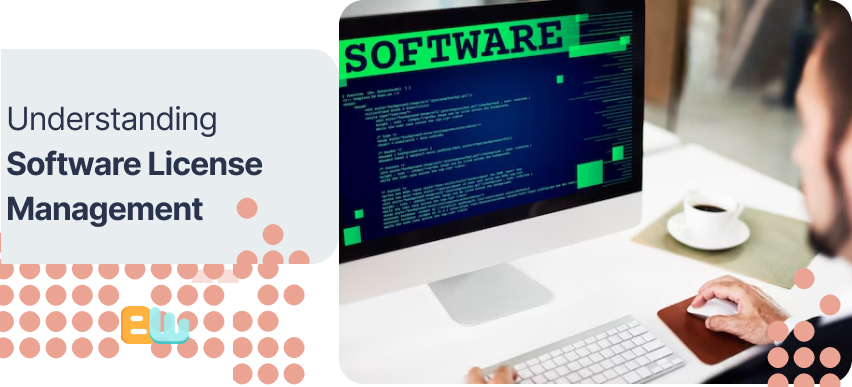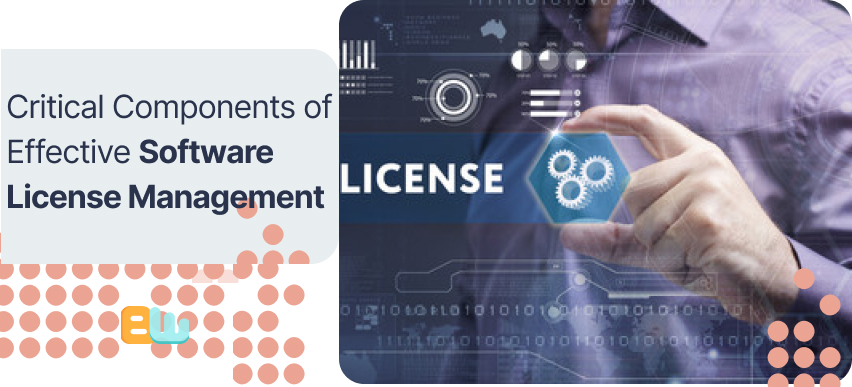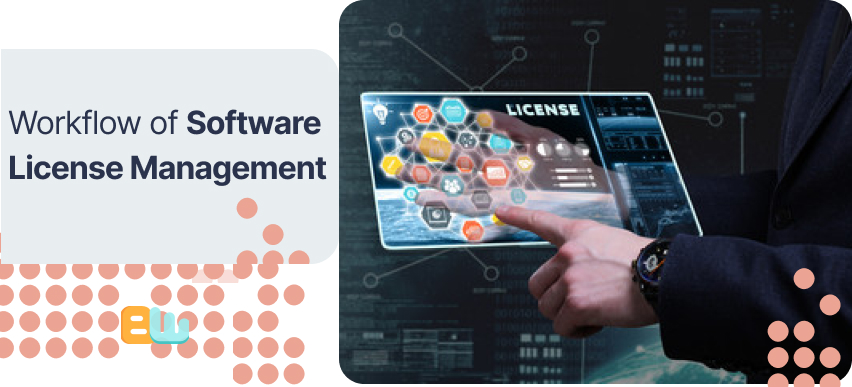
Software License Management can be a nightmare for any organization. Keeping tabs on all your licenses can be daunting with the constantly changing software landscape. This is where software license management comes in handy. It helps organizations keep track of their software usage, ensure compliance with end-user license agreements, and mitigate risks associated with non-compliance. This blog post will take a deep dive into software license management, covering its role, importance, and benefits. We will also explore the critical components of effective software license management and discuss the essential features to look for in license management software. Lastly, we will provide tips on mitigating risks associated with software license management and share some best practices you can implement in your organization.
Understanding Software License Management

Effective software license management ensures adherence to end-user license agreements, enabling organizations to make well-informed decisions about their software investments. This process involves the efficient management and optimization of software usage, assets, and costs, leading to potential cost savings and the avoidance of legal penalties. Furthermore, utilizing software license management tools is crucial for effective license management, providing essential support in tracking asset management, facilitating software audits, and ensuring compliance with various types of licenses at first glance.
The Role and Importance of Software License Management
Effective asset management is crucial in software license management, enabling organizations to track software license usage and ensure compliance with regulatory requirements. Commercial software relies heavily on effective license management to avoid legal ramifications and security vulnerabilities. Moreover, adhering to best practices and industry standards is imperative for robust license management. License managers play a pivotal role in maintaining compliance and optimizing costs for software companies and vendors by integrating IT asset management and software audits. This comprehensive approach also involves identifying critical features and types of licenses for a first-glance understanding, aligning with the goal of maximizing value from software investments.
How Software License Management Can Benefit Your Company
Effective software license management can lead to cost savings and better software asset management for business leaders to optimize software costs and usage. It also aids in managing the types of software licenses across large enterprises, supporting remote work and educational institutions. Proper software license management can help avoid unused licenses and expenses, contributing to better resource allocation. Additionally, license management solutions can support businesses in managing software audits, ensuring compliance with end-user license agreements, and optimizing IT asset management. This, in turn, helps in aligning with best practices and industry standards, benefiting the company in numerous ways.
Critical Components of Effective Software License Management

Automated license management optimizes software license tasks, while centralized management simplifies licensing. Establishing a system for software license management is crucial, and robust management tools support diverse license types. Effective compliance and agreement management are integral to the process.
Establishing a Centralized License Management System
Establishing a centralized system for managing licenses provides valuable insights into software license data, supporting proprietary and open-source software. This system caters to specific software licensing terms and organizational needs, facilitating software inventory management across industries. Furthermore, it aligns with IT assets and software usage, streamlining software license management tasks and ensuring effective license compliance and management of software license agreements. Establishing a centralized license management system is crucial for software companies and vendors, providing a first glance at key features and types of licenses, ultimately promoting efficient asset management and software audits.
Automating License Management Tasks
Automating license management tasks alleviates the manual burden, streamlining software licensing management and ensuring compliance. Utilizing license management software supports end users and IT managers, fostering efficient management, especially in large enterprise environments. The automation enables a first glance into critical features, types of licenses, and software audits, benefiting software companies and developers. Integrating asset management with automated license manager tools eases the complexities faced by software vendors, ultimately optimizing software license management processes.
Ensuring Compliance with End User License Agreements
Mitigating legal penalties involves the effective management of end-user license agreements. Tools supporting this task manage software licenses according to licensing terms and public domain licenses. Compliance safeguards software investments and assets by covering license usage, terms, and software license agreement management, including NLP terms like asset management, license manager, and software vendor at first glance to enhance the content’s NLP.
Tackling Technological Obstacles
License management solutions are crucial in addressing technological obstacles encountered in software licensing. These solutions effectively manage software license usage and costs, supporting IT service management, software usage, and source code management. Additionally, they tackle software licensing system challenges, ensuring compliance with software license management regulations. The solutions streamline the overall process by addressing software licensing management issues and ensuring software license compliance, offering valuable support to software developers, software companies, and IT managers.
Workflow of Software License Management

Software license management workflow involves tracking license usage and the number of licenses and ensuring license compliance. It encompasses internal audits and software management, providing practical solutions for software usage, license data, and compliance management. This process is essential for software companies and vendors to manage their IT assets efficiently. Organizations can ensure comprehensive license management and minimize non-compliance risks by automating software audits and integrating software license management across IT. At first glance, it’s clear that this workflow plays a crucial role in ensuring the smooth functioning of software license management systems.
Tracking Software License Usage
Monitoring the utilization of software licenses is pivotal for optimizing license management. This process involves overseeing software license usage, managing associated costs, and ensuring compliance with licensing agreements. Practical license management tools facilitate the seamless tracking of software license usage. Additionally, this encompasses monitoring the use of licenses for commercial software and overall software licensing management to make informed decisions about investments in software. Organizations can efficiently manage and align their software assets with business needs by tracking software license usage, maximizing the value derived from software investments.
Setting Up Software License Alerts
Software license alerts ensure compliance with license terms and prevent legal penalties. By providing automated notifications of license usage breaches, they contribute to significant cost savings. Real-time alerts enable efficient management of software assets, allowing for proactive management of software licenses. Additionally, these alerts assist in identifying unused licenses, thereby optimizing software investments and aiding in effective asset management. Implementing this key feature is essential for software companies and developers to maintain compliance and make informed decisions about their software investments.
Automating Software License Management
Automating the management of licenses is essential for streamlining processes and ensuring compliance with best practices. By implementing automated license management tools, software companies can significantly reduce the risk of unlicensed software usage. This automation facilitates efficient software inventory and enables effective software license compliance and usage tracking. Its asset management is greatly improved through automation, allowing for a first glance at the key features and types of licenses. Ultimately, automating software license management is crucial for software developers and vendors to maintain control and visibility over their license usage, ensuring optimal utilization and compliance.
Integrating Software License Management Across IT
Integrating software license management across IT provides a holistic view of license data throughout the organization, enhancing license management efficiency. The centralized integration ensures better decision-making and optimizes software costs and usage. This comprehensive approach facilitates effective license management, reducing security vulnerabilities. By integrating software licensing management tools, organizations can streamline processes, improve compliance, and gain valuable insights into their software assets, thereby mitigating risks and maximizing the value of IT asset management.
Essential Features to Look for in a License Management Software

Robust software license compliance and reporting are vital features in license management software, ensuring adherence to NLP terms like software audits and IT asset management. Flexible licensing models cater to specific needs, assisting software companies and developers. Trial and evaluation licenses enable informed decision-making on software investments, benefitting software vendors and companies at first glance. Multi-platform support in license management tools accommodates diverse software applications, supporting various types of licenses. Effective license management software should help commercial, open source, and proprietary software licenses, establishing visibility into software usage for better management.
License Compliance and Reporting
Practical software license management tools ensure adherence to licensing terms, preventing legal implications. These tools also facilitate internal audits and reporting, promoting best practices in software licensing. Comprehensive compliance and reporting features minimize financial penalties, and real-time compliance reports reduce legal risks. In addition, efficient license management tools offer insights into the type of license being used and provide valuable data for software audits. This enables software companies to make informed decisions and minimize risks associated with non-compliance.
Flexible Licensing Models
Adapting to the needs of organizations, flexible licensing models in software license management provide tailored solutions for E-commerce in modern day business and software industry requirements. These models support significant enterprise needs and optimize software expenses, ensuring cost savings. Effective software license management solutions are achieved by enabling adaptable licensing models, addressing varied organizational needs, and promoting efficient utilization of resources.
Trial and Evaluation Licenses
Trial and evaluation licenses enable software use without long-term commitments, facilitating an assessment of features and functionality before purchase. They play a vital role in understanding software usage and supporting software asset management, aiding end users in comprehending usage and associated costs to make informed investment decisions. By utilizing trial and evaluation licenses, software companies and developers can provide potential clients with a first glance at the key features and type of license available, leading to informed decision-making and streamlined software audits.
Multi-Platform Support
Multi-platform support in license management tools caters to diverse software applications, ensuring effective management of various types of licenses. This comprehensive feature facilitates software usage management and enables effective license management across the organization. Asset management and software audits are streamlined through multi-platform support, benefiting software companies and developers. License managers with multi-platform support provide visibility into the type of licenses utilized and aid in establishing compliance with end-user license agreements. Furthermore, this feature is crucial in integrating software license management across IT, benefitting organizations and software vendors at first glance.
Mitigating Risks in Software License Management

Mitigating risks in software license management entails analyzing software usage data to reduce security vulnerabilities. Effective management of software licenses and agreements is crucial for risk mitigation. Efficient license management helps in averting data breaches related to software usage and minimizes the risks of legal penalties and financial ramifications. Mitigating risks through license management tools involves optimizing software costs and use, thus ensuring compliance and reducing potential threats. Establishing visibility into software usage, monitoring license expirations, and identifying unauthorized software installations are essential aspects of risk mitigation in software license management.
Analyzing Software Usage Data
Analysis of software usage data leads to informed decision-making for software investments, optimizing assets, and reducing unused licenses. It ensures effective cost management, aids in identifying and meeting organizational needs, and optimizes software license compliance. Utilizing software usage data for decision-making optimizes its asset management, aiding software companies and developers in determining the type of license and critical features that best suit their needs. Additionally, it assists in software audits and helps monitor license expirations, providing a first glance into the effectiveness of software license management.
Establishing Visibility into Software Usage
Establishing visibility into software usage involves gaining insight into usage patterns to optimize licensing costs. It also includes identifying underutilized software assets to achieve cost savings and improve efficiency. Furthermore, ensuring compliance with licensing terms by tracking software usage data is essential. Implementing best practices in software license management is crucial for effective cost control and making informed decisions about software investments based on usage data. Organizations can optimize their spending by establishing visibility into software usage and ensuring they make the most of their software resources.
Monitoring License Expirations
Protect your company from legal penalties by proactively monitoring license agreements to prevent expired licenses. Utilize software license management tools to automate tracking and stay informed about upcoming expirations, avoiding financial penalties. Ensure compliance by managing license terms and renewals and protect against security vulnerabilities with up-to-date licenses. Staying ahead of expirations can mitigate risks associated with outdated licenses, software audits, and unauthorized installations. Asset management and license managers play a crucial role in this process, allowing software companies and developers to navigate the complexities of license agreements effectively. At first glance, the key features and license types are essential for software vendors.
Identifying Unauthorized Software Installations
Unauthorized software installations pose a significant risk, both legally and financially. Implementing software asset management and conducting internal audits are crucial in detecting and addressing unlicensed software usage. Organizations can effectively track and manage license data by utilizing software license management solutions, thereby mitigating the risks associated with unauthorized software installations. Monitoring software usage plays a crucial role in identifying and addressing unlicensed applications. Identifying unauthorized software installations requires a comprehensive approach that integrates asset management, software audits, and proactive measures to ensure compliance and security.
Conclusion
Effective software license management is crucial for businesses to ensure compliance, optimize costs, and mitigate risks. Companies can streamline their software license management process by implementing a centralized license management system, automating tasks, and ensuring compliance with end-user license agreements. Tracking software license usage, setting up alerts, and integrating license management across IT can help maintain control and visibility. When choosing a license management software, consider features like license compliance and reporting, flexible licensing models, trial and evaluation licenses, and multi-platform support. Businesses can effectively manage their software licenses and maximize their investment by analyzing software usage data, establishing visibility, monitoring license expirations, and identifying unauthorized installations. Choose the right software license management solution to simplify the process and drive efficiency in your organization.
